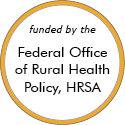Rural Project Examples: Outpatient care
Promising Examples
The Rural Virtual Infusion Program

Updated/reviewed November 2025
- Need: Allow rural cancer patients in a region inclusive of 26 counties in Iowa, Minnesota, and South Dakota to have access to tertiary-level chemotherapy regimens administered in rural infusion centers.
- Intervention: With telehealth-based oversight from a tertiary care oncology team, 3 rural infusion teams were trained to coordinate cancer treatment plans and administer complex chemotherapy regimens.
- Results: The original grant-supported effort — with its results of saving130 patients 65,000 trip miles and 1,800 travel hours – proved sustainable.
Other Project Examples
CMH Addiction Recovery Program

Updated/reviewed November 2025
- Need: To help individuals and families impacted by substance use disorder access treatment and counseling in rural Missouri.
- Intervention: The CMH Addiction Recovery Program provides medication-assisted treatment, counseling, peer and family support, and other related services within a Rural Health Clinic.
- Results: The program operates 5 days a week and sees 400 patients each month.
Avita Health System Comprehensive Cardiology Program
Added April 2021
- Need: Population health approach to decreasing area deaths from cardiovascular disease.
- Intervention: A health system-level investment in level II cardiac catheterization services and the required specialized cardiology workforce.
- Results: Since August 2018, the Avita Health System in north central Ohio has provided local cardiovascular services that have decreased hospital transfers, increased care coordination, and provided education and prevention activities that, with time, will impact population health cardiovascular outcomes.
Garrett County Regional Cancer Patient Navigator Program

Updated/reviewed March 2020
- Need: Comprehensive cancer services for residents of an 8-county, 3-state area in Appalachia.
- Intervention: Using a Cancer Patient Navigation Tool Kit, a Maryland acute care facility led a multidisciplinary collaboration that provided the area's patients with expanded cancer treatment services.
- Results: In addition to several new cancer-related programs, expanded services are now available for cancer patients, families, and cancer survivors.
For examples from other sources, see:
